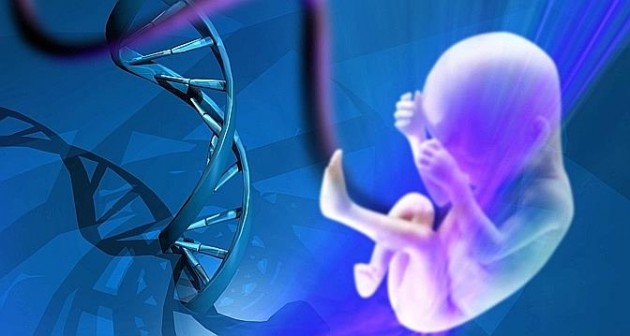
New research has identified small non-coding RNAs (a kind of microRNA) has a possible mediator in the intergenerational transmission of trauma. Here is how those sncRNAs do their work:
Mansuy and her team have succeeded in identifying a key component of these processes: short RNA molecules. These RNAs are synthetized from genetic information (DNA) by enzymes that read specific sections of the DNA (genes) and use them as template to produce corresponding RNAs. Other enzymes then trim these RNAs into mature forms. Cells naturally contain a large number of different short RNA molecules called microRNAs. They have regulatory functions, such as controlling how many copies of a particular protein are made.The researchers found that traumatic stress alters the amount of several microRNAs in the blood, brain, and sperm. Some microRNAs were over-produced, others were lower than in the corresponding tissues or cells of control animals. These alterations resulted in misregulation of cellular processes normally controlled by these microRNAs.
After exposure to traumatic experiences, the mice lost their natural aversion to open spaces and bright light and had depressive-like behaviors. These behavioral symptoms were also transferred to the next generation via sperm, even though the offspring were not exposed to any traumatic stress themselves, and then to a third generation as well.
Interestingly, as has been reported in other headlines, the trauma is passed down through the father's sperm, not the mother's egg (as far we know right now).
Scientists unmask a piece in the puzzle of how the inheritance of traumas is mediated
April 13, 2014
The consequences of traumatic experiences can be passed on from one generation to the next. Credit: Isabelle Mansuy / UZH / ETH Zurich
The phenomenon has long been known in psychology: traumatic experiences can induce behavioural disorders that are passed down from one generation to the next. It is only recently that scientists have begun to understand the physiological processes underlying hereditary trauma. "There are diseases such as bipolar disorder, that run in families but can't be traced back to a particular gene", explains Isabelle Mansuy, professor at ETH Zurich and the University of Zurich. With her research group at the Brain Research Institute of the University of Zurich, she has been studying the molecular processes involved in non-genetic inheritance of behavioural symptoms induced by traumatic experiences in early life.
Mansuy and her team have succeeded in identifying a key component of these processes: short RNA molecules. These RNAs are synthetized from genetic information (DNA) by enzymes that read specific sections of the DNA (genes) and use them as template to produce corresponding RNAs. Other enzymes then trim these RNAs into mature forms. Cells naturally contain a large number of different short RNA molecules called microRNAs. They have regulatory functions, such as controlling how many copies of a particular protein are made.
Small RNAs with a huge impact
The researchers studied the number and kind of microRNAs expressed by adult mice exposed to traumatic conditions in early life and compared them with non-traumatized mice. They discovered that traumatic stress alters the amount of several microRNAs in the blood, brain and sperm – while some microRNAs were produced in excess, others were lower than in the corresponding tissues or cells of control animals. These alterations resulted in misregulation of cellular processes normally controlled by these microRNAs.
After traumatic experiences, the mice behaved markedly differently: they partly lost their natural aversion to open spaces and bright light and had depressive-like behaviours. These behavioural symptoms were also transferred to the next generation via sperm, even though the offspring were not exposed to any traumatic stress themselves.
Even passed on to the third generation
The metabolism of the offspring of stressed mice was also impaired: their insulin and blood-sugar levels were lower than in the offspring of non-traumatized parents. "We were able to demonstrate for the first time that traumatic experiences affect metabolism in the long-term and that these changes are hereditary", says Mansuy. The effects on metabolism and behaviour even persisted in the third generation.
"With the imbalance in microRNAs in sperm, we have discovered a key factor through which trauma can be passed on", explains Mansuy. However, certain questions remain open, such as how the dysregulation in short RNAs comes about. "Most likely, it is part of a chain of events that begins with the body producing too much stress hormones."
Importantly, acquired traits other than those induced by trauma could also be inherited through similar mechanisms, the researcher suspects. "The environment leaves traces on the brain, on organs and also on gametes. Through gametes, these traces can be passed to the next generation."
Mansuy and her team are currently studying the role of short RNAs in trauma inheritance in humans. As they were also able to demonstrate the microRNAs imbalance in the blood of traumatized mice and their offspring, the scientists hope that their results may be useful to develop a blood test for diagnostics.
Explore further: DNA modifications measured in blood signal related changes in the brain
More information: Gapp K, Jawaid A, Sarkies P, Bohacek J, Pelczar P, Prados J, Farinelli L, Miska E, Mansuy IM. (2014, Apr 13). Implication of sperm RNAs in transgenerational inheritance of the effects of early trauma in mice. Nature Neuroscience, DOI: 10.1038/nn.3695
Journal reference: Nature Neuroscience

Provided by ETH Zurich
* * * * *
Here is the abstract from Nature Neuroscience, the full article is behind a pay-wall.
Implication of sperm RNAs in transgenerational inheritance of the effects of early trauma in mice
Katharina Gapp, Ali Jawaid, Peter Sarkies, Johannes Bohacek, Pawel Pelczar, Julien Prados, Laurent Farinelli, Eric Miska & Isabelle M Mansuy
Small non-coding RNAs (sncRNAs) are potential vectors at the interface between genes and environment. We found that traumatic stress in early life altered mouse microRNA (miRNA) expression, and behavioral and metabolic responses in the progeny. Injection of sperm RNAs from traumatized males into fertilized wild-type oocytes reproduced the behavioral and metabolic alterations in the resulting offspring.

No comments:
Post a Comment